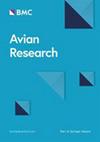Are urbanization, biotic and social factors associated with the song frequency and song entropy attributes of three urban syntopic passerines?
IF 1.7
2区 生物学
Q1 ORNITHOLOGY
引用次数: 0
Abstract
Urban environments have challenging characteristics for bird acoustic communication. High levels of anthropogenic noise, as well as vegetation structure (e.g., in urban parks), can potentially affect the song frequency characteristics of several bird species. An additional factor such as the abundance of conspecific and heterospecific vocalizing birds may play an important role in determining the structure of bird songs. In this study, we analyzed whether noise levels, vegetation percentage, and abundance of conspecifics and heterospecifics influence the song characteristics of three syntopic songbird species: House Finch (Haemorhous mexicanus), Rufous-collared Sparrow (Zonotrichia capensis), and House Sparrow (Passer domesticus) living in urban sites. We recorded songs of these species and measured the peak frequency and entropy of their songs at 14 sites in the city of San Cristobal de Las Casas, Chiapas, Mexico. We found that the song peak frequency of House Finch and House Sparrow's songs was negatively related to the vegetation. The peak frequency of neither of the three species correlated with the average noise level. However, the abundances of conspecific and heterospecific were related to the peak frequency of the three species' songs. The entropy of the House Finch and House Sparrow songs was positively and negatively related, respectively, to noise levels. House Sparrow song entropy was negatively related to the percentage of vegetation. Song entropy of House Finches was negatively associated to conspecific and House Sparrow abundance. Song entropy of Rufous-collared Sparrows was positively related to conspecific abundance. In conclusion, the song peak frequency and song entropy of the three songbird species were differentially related to urban noise, vegetation, and conspecific and heterospecific abundance, suggesting these factors influence bird song characteristics.
城市化、生物和社会因素是否与三种城市合成类雀形目动物的鸣叫频率和鸣叫熵属性有关?
城市环境对鸟类的声学交流具有挑战性。高水平的人为噪音以及植被结构(例如,在城市公园中)可能会影响几种鸟类的鸣叫频率特征。另一个因素,如同种和异种发声鸟类的丰度,可能在决定鸟类鸣叫的结构中起重要作用。在本研究中,我们分析了噪声水平、植被比例、同种和异种的丰度是否会影响生活在城市的三种同种鸣禽:墨西哥雀(Haemorhous mexicanus)、红颈雀(Zonotrichia capensis)和家雀(Passer domesticus)的鸣叫特征。我们在墨西哥恰帕斯州圣克里斯托瓦尔德拉斯卡萨斯市的14个地点记录了这些物种的歌曲,并测量了它们歌曲的峰值频率和熵。结果表明,雀和家雀的鸣声峰值频率与植被呈负相关。三种动物的峰值频率均与平均噪声水平无关。然而,同种和异种的丰度与三种鸣声的峰值频率有关。家雀和家雀歌声的熵分别与噪声水平呈正相关和负相关。家雀鸣叫熵与植被比例呈负相关。家雀鸣叫熵与同种家雀和家雀丰度呈负相关。红颈麻雀的鸣声熵与同种丰度呈正相关。综上所述,三种鸣禽的鸣声峰值频率和鸣声熵与城市噪声、植被、同种和异种丰度的相关性存在差异,表明这些因素影响了鸣声特征。
本文章由计算机程序翻译,如有差异,请以英文原文为准。
求助全文
约1分钟内获得全文
求助全文
来源期刊

Avian Research
ORNITHOLOGY-
CiteScore
2.90
自引率
16.70%
发文量
456
审稿时长
46 days
期刊介绍:
Avian Research is an open access, peer-reviewed journal publishing high quality research and review articles on all aspects of ornithology from all over the world. It aims to report the latest and most significant progress in ornithology and to encourage exchange of ideas among international ornithologists. As an open access journal, Avian Research provides a unique opportunity to publish high quality contents that will be internationally accessible to any reader at no cost.
 求助内容:
求助内容: 应助结果提醒方式:
应助结果提醒方式:


